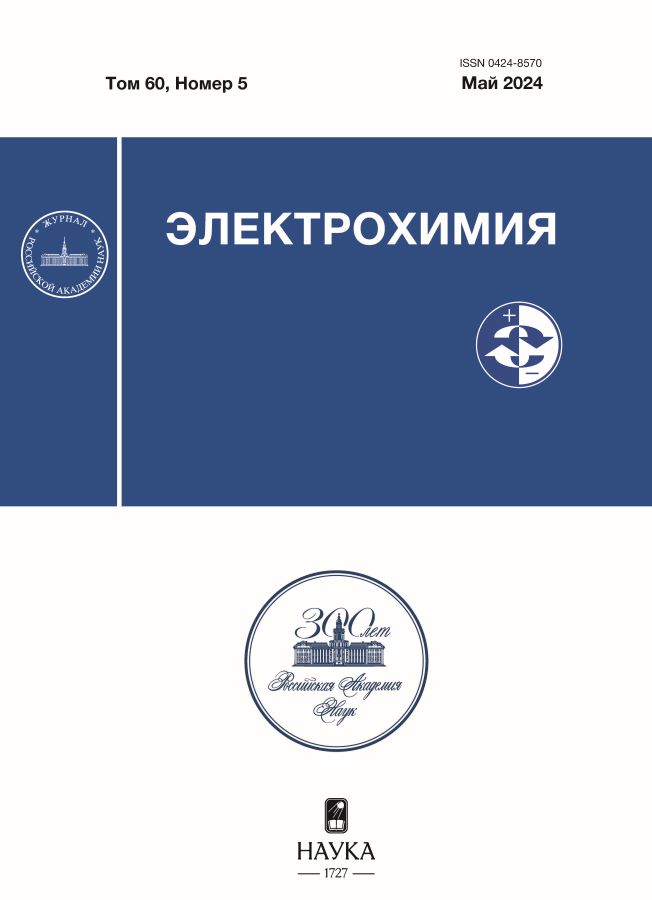Analysis of the electrochemical impedance spectra and the structure of the solid electrolyte interphase on electrodeposited metallic lithium using the distribution of relaxation times method
- Authors: Alpatov S.S.1, Vasiliev F.A.1, Aleshina V.K.2, Vagramyan T.A.2, Semenikhin O.A.1
-
Affiliations:
- Lomonosov Moscow State University M. V. Lomonosov, Faculty of Chemistry
- Russian University of Chemical Technology DI. Mendeleev
- Issue: Vol 60, No 5 (2024)
- Pages: 361-372
- Section: Articles
- URL: https://medjrf.com/0424-8570/article/view/671388
- DOI: https://doi.org/10.31857/S0424857024050041
- EDN: https://elibrary.ru/qnpwor
- ID: 671388
Cite item
Abstract
The goal of this work was to confirm our earlier conclusion that the regularities observed during the electrodeposition of metallic lithium on copper and lithium electrodes can be associated with differences in the properties of the so-called solid electrolyte interphase (SEI), which is formed on these electrodes in contact with the electrolyte. To do this, we analyzed the electrochemical impedance spectra measured during the above processes by the method of distribution of relaxation times (DRT). It was shown that the addition of surfactants to the electrolyte such as cetyltrimethylammonium bromide and hexadecylpyridinium bromide lead to a significant change in the properties of the SEI layers and a noticeable increase in the values of the impedance components associated with the Faradaic processes on these electrodes, which indicates inhibition of the lithium electrodeposition processes and the related process of dendrite formation under these conditions. At the same time, no such impedance components were observed on the freshly formed deposit, which confirms our earlier conclusion that the effects of surfactants on dendrite formation are associated with the changes in the properties of SEI layers in the presence of surfactants rather than the surfactants adsorbing on lithium and blocking the dendrite growth.
Full Text
About the authors
S. S. Alpatov
Lomonosov Moscow State University M. V. Lomonosov, Faculty of Chemistry
Email: osemenik@elch.chem.msu.ru
Russian Federation, Moscow
F. A. Vasiliev
Lomonosov Moscow State University M. V. Lomonosov, Faculty of Chemistry
Email: osemenik@elch.chem.msu.ru
Russian Federation, Moscow
V. Kh. Aleshina
Russian University of Chemical Technology DI. Mendeleev
Email: osemenik@elch.chem.msu.ru
Russian Federation, Moscow
T. A. Vagramyan
Russian University of Chemical Technology DI. Mendeleev
Email: osemenik@elch.chem.msu.ru
Russian Federation, Moscow
O. A. Semenikhin
Lomonosov Moscow State University M. V. Lomonosov, Faculty of Chemistry
Author for correspondence.
Email: osemenik@elch.chem.msu.ru
Russian Federation, Moscow
References
- Алпатов, С. С., Васильев, Ф. А., Алешина, В. Х., Ваграмян, Т. А., Семенихин, О. А. Электроосаждение лития в присутствии поверхностно-активных веществ. Электрохимия. 2024. Т. 60. № 5. С. 349.
- Тихонов, А. Н. О регуляризации некорректно поставленных задач. Докл. АН СССР. 1963. Т. 153. С. 49.
- Wan, T. H., Saccoccio, M., Chen, C., and Ciucci, F., Influence of the discretization methods on the distribution of relaxation times deconvolution: implementing radial basis functions with DRTtools, Electrochim. Acta, 2015, vol. 184, p. 483.
- Ciucci, F. and Chen, C., Analysis of electrochemical impedance spectroscopy data using the distribution of relaxation times: A Bayesian and hierarchical Bayesian approach, Electrochim. Acta, 2015, vol. 167, p. 439.
- Effat, M. B. and Ciucci, F., Bayesian and hierarchical Bayesian based regularization for deconvolving the distribution of relaxation times from electrochemical impedance spectroscopy data, Electrochim. Acta, 2017, vol. 247, p. 1117.
- GitHub repository. Ciuccislab. DRTtools. URL: https://github.com/ciuccislab/DRTtools (дата обращения 19.08.2023)
- Heiskanen, S.K., Kim, J., and Lucht, B.L., Generation and Evolution of the Solid Electrolyte Interphase of Lithium-Ion Batteries, Joule, 2019, vol. 3, p. 2322.
- Wu, H., Jia, H., Wang, C., Zhang, J.-G., and Xu, W., Recent Progress in Understanding Solid Electrolyte Interphase on Lithium Metal Anodes, Adv. Energy Mater., 2021, vol. 11, p. 2003092.
- Алексеева, Е. Ю., Сафонов, В. А., Петрий, О. А. Потенциалы нулевого заряда и строение двойного электрического слоя на платине и палладии в среде диметисульфоксида. Электрохимия. 1984. Т. 20. С. 945.
- Lonchakova, O.V., Semenikhin, O.A., Zakharkin, M.V., Sergeyev, V.G., and Antipov, E.V., Efficient gel-polymer electrolyte for sodium-ion batteries based on poly(acrylonitrile-co-methyl acrylate), Electrochim. Acta, 2020, vol. 334, p. 135512.
- Semenikhin, O.A., Ovsyannikova, E.V., Alpatova, N.M., and Rotenberg, Z.A., Dynamic impedance measurements on a thin-film poly-3-methylthiophene electrode: memory effects and space charge formation, J. Electroanal. Chem., 1996, vol. 408, p. 67.
- Semenikhin, O.A., Hossain, M.M.D., and Workentin, M.S., Photoelectrochemistry of Conducting Polymers Modified with Electron-Acceptor Moieties, J. Phys. Chem. B, 2006, vol. 110, p. 20189.
- Su, L., Charalambous, H., and Cui, Z., High-efficiency, anode-free lithium–metal batteries with a close-packed homogeneous lithium morphology, Energy Environ. Sci., 2022, vol. 15, p. 843.
- Tong, Z., Bazri, B., Hu, S.-F., and Liu, R.-S., Interfacial chemistry in anode-free batteries: challenges and strategies, J. Mater. Chem. A, 2021, vol. 9, p. 7396.
Supplementary files














